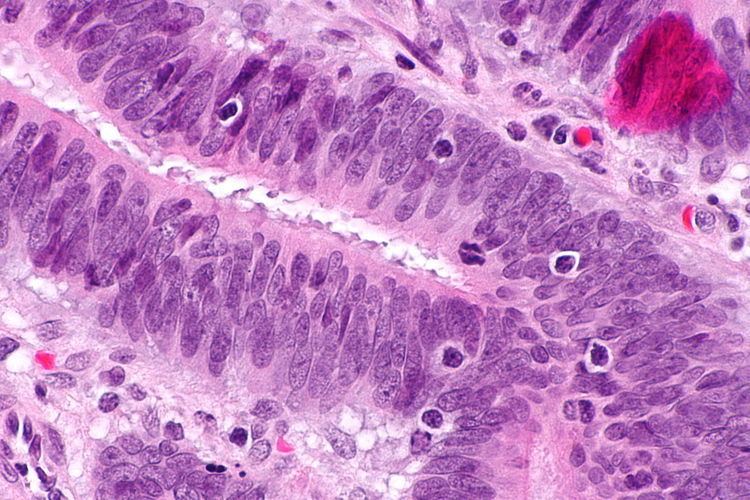 | ||
Tumor-infiltrating lymphocytes, also tumour infiltrating lymphocytes, are white blood cells that have left the bloodstream and migrated into a tumor. They are mononuclear immune cells, a mix of different types of cells (i.e., T cells, B cells, NK cells, macrophages) in variable proportions, T cells being the most abundant cells.
Contents
- Detection and characteristics
- Colorectal cancer
- Melanoma
- Use in an autologous cell therapy
- History
- for Melanoma
- for Other cancers
- References
They can often be found in the stroma and within the tumour itself.
TILs are implicated in killing tumor cells. The presence of lymphocytes in tumors is often associated with better clinical outcomes.
Detection and characteristics
When TILs are present the lymphocytes are found between the tumor cells; cells in the stroma surrounding the tumor cells do not count. It should be noted that histologic definitions for TILs vary.
CD3 has been used to detect lymphocytes in tumor samples. Tumor immune infiltration can also be determined using gene expression methods like Micro array or RNA Sequencing. Detection of gene expression specific for different kind of immune cell populations can then be used to determine the degree of lymphocyte infiltration as has been shown in breast cancer. An active immune environment within the tumor often indicates a better prognosis as can be determined by the Immunological constant of rejection.
Colorectal cancer
In colorectal cancer, they are associated with microsatellite instability cancers, as may be seen in Lynch syndrome.
TILs are needed for checkpoint inhibitor therapy to work in GI cancers.
Melanoma
They are an important prognostic factor in melanoma and higher levels being associated with a better outcome.
Use in an autologous cell therapy
They are key to an experimental autologous cell therapy (Contego) for metastatic melanoma.
History
The use of TILs as an adoptive cell transfer therapy to treat cancer was pioneered by Dr. Steven Rosenberg at the National Cancer Institute. Autologous lymphocytes are isolated from patients’ tumors and cultured to large numbers of cells in vitro. Prior to TIL treatment, patients are given nonmyeloablative chemotherapy to deplete native lymphocytes that can inhibit the response. Once lymphodepletion is completed, patients are infused with TILs in combination with interleukin 2 (IL-2). Lion Biotechnologies is developing adoptive cell transfer with TILs as a cancer therapy.
for Melanoma
Several centres are currently working on TIL melanoma treatment protocol, including the Ella Institute in Sheba Hospital, Israel and Copenhagen University Hospital at Herlev, Denmark
Clinical trials have used TILs to treat patients with metastatic melanoma. Tumor reduction of 50% or more was observed in about half of patients. Some patients experienced complete responses with no detectable tumor remaining years after treatment.
for Other cancers
Clinical trials using TILs to treat digestive tract cancers, such as colorectal cancer, and cancers associated with the human papilloma virus (HPV), such as cervical cancer, are ongoing.
Under investigation are the use of TILs to treat other tumors, including lung, ovarian, bladder, and breast.
